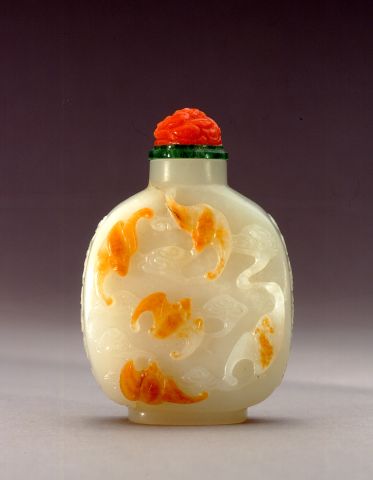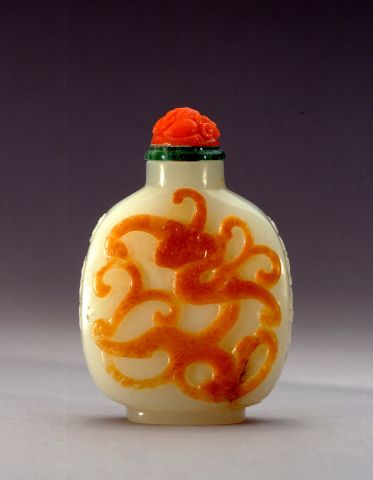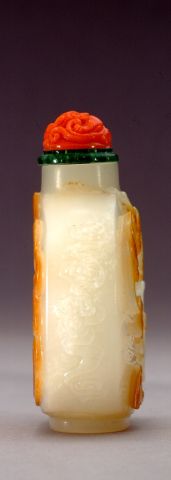


Bottle ID: 455
WHITE, PEBBLE, CHI DRAGON AND BATS
Date: 1750-1850
Height: 57 mm
Nephrite, white with russet skin, very well hollowed, of flattened ovoid form with sloping shoulders and a neatly carved footrim, carved in relief using the skin with, on one side, a chi dragon, and on the reverse with five bats swooping amongst formalized white clouds, the narrow sides also with formalized clouds.
Similar Examples:
Crane Collection nos. 149, 229, 320 and 516
Crane Collection no. 520
Sotheby's, New York, March 17, 1997, lot 205, A Private Collection.
Provenance:
Hugh Moss [HK] Ltd.
Exhibited:
Annual Convention ICSBS New York, November 2013
Published:
JICSBS, Autumn 2013, Front Cover
Stylistic differences in bottles that appear to have come from the same raw boulders provide us with a strong argument for the existence of more than one workshop in Suzhou. Outside the Imperial workshops, the system was that the workshop would have been a specialized family affair which passed on the traditions of production from one generation to another. The master carver would have assistants to perform the less demanding tasks whilst remaining under his supervision. Hollowing, polishing and cutting may all have been done by different workers leaving the fine carving and design to the master. One result of the "many hands" approach is that the output of a workshop, particularly a commercial one is increased, resulting in a bottle taking only 2-3 months to be made rather than several months or even years.
It is difficult to know where to place this style of carving as it has elements of 'Suzhou', 'Palace' and 'Master of the Rocks' styles. Wherever it was made, it is stunning. The carving of the two sides provide a contrast between the formal, rounded chi dragon, reminiscent of Imperial work and the fluid swooping bats, with the ‘double overlay’ style skin carving. Using both a thin russet skin and the background stone color for a middle plane of relief, the carver has created one of the most interesting carvings of bats and clouds. The Archives of the Imperial Household Department tell us that jade carvers were seconded to the glass workshops within the Palace compound and it is entirely possible that the carver of this jade bottle was inspired by the double and triple overlay carved bottles fashioned in glass.
< Back to full list
 English
English 中文
中文